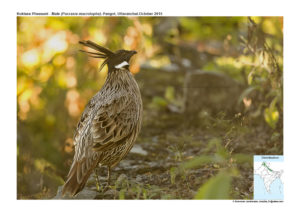
Koklass Pheasant Pucrasia macrolopha
Etymology:
- Pucrasia : Garhwali name Pukrasfor the Koklas Pheasant
- Macrolopha: Greek word makros – long; lophos –
Vernacular Names: Kash: Plas, H.P:Kukrola, Koklas, Kokla, Khawakhtar, U.P.: Pokras, Nepal: Kokras
Distribution in India: Resident Western Himalayas in India
Description: Size of male is 58–64 cm with tail size of 22–28 cm, wt. of 1135–1415 g; size of female 52·5–56 cm with tail size of 17–19·5 cm, wt. of 930–1135 g. It is a medium sized pheasant with fully feathered face in both sexes. The male has a bottle-green head and ear tufts, chestnut on breast and streaked appearance to the body.The female has white throat, short buff ear tufts and streaked body.Both the sexes have wedge shaped tail. The juvenile, including first-year male are similar to adult female. The males of macrolopha race have less chestnut in plumage, restricted to centre of breast and belly, mantle and sides of breast are pale grey, streaked with black. The race biddulphi is somewhat intermediate between other members of the “Himalayan” group in having maroon hindneck and underparts, often with a grey mantle and brownish tail, while female is darker than nominate.
Habitat: It is found in coniferous and mixed forests in steep terrain.They roost in trees. It is found from 1600 m to 4000 m.
Food habits: It eats variety of seeds,acorns, berries and buds,insects and worms. Loose flocks form in winter, but is mostly observed singly or in pairs. It forages in early morning and late afternoon.
Breeding habits: They breed in Apr–Jun in Himalayas. The Nest is a scrape in ground, under dense cover, lined to some extent with twigs and leaves. They lay a clutch of 5–7 egg. The incubation period is 26–27 days done by female alone.